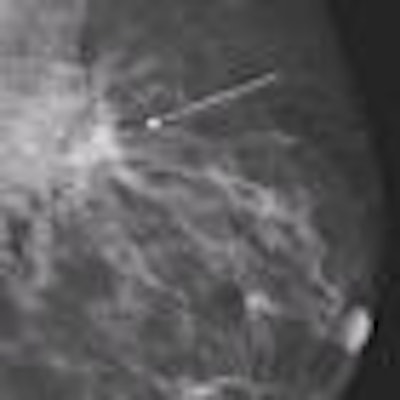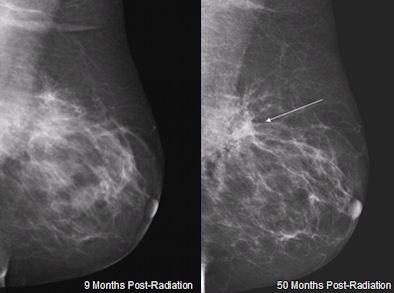
CHICAGO - The majority of breast cancer patients who received MammoSite balloon brachytherapy treatment developed symptoms of moderate breast distortion within two years of treatment, according to an RSNA presentation on Tuesday.
Radiologists who identify early fibrosis in follow up mammograms of these patients need to be cautious about recommending biopsy, if the findings from Boston's Brigham and Women's Hospital are representative.
Anecdotally, breast specialists at Brigham and Women's Hospital and the Dana-Farber Cancer Institute in Boston were observing that patients who underwent breast brachytherapy treatment using the MammoSite balloon catheter Hologic, Bedford, MA, seemed to develop fibrosis earlier than patients who underwent conventional whole-breast radiation. This is believed to be the first study to document this finding.
 |
| Mammogram of 53-year-old woman nine months following MammoSite brachtherapy shows mild distortion (left image). Retraction, increased density, and moderate distortion as highlighted by arrow have developed 50 months following treatment. Courtesy of Brigham and Women's Hospital. |
Women who are offered accelerated partial breast irradiation (APBI) treatment represent a low-risk group of patients with early-stage breast cancer. To date, more than 32,000 women in the U.S. alone have opted for this rapid and convenient form of radiation therapy following breast conservation surgery.
Researchers at Brigham and Women's Hospital conducted a retrospective review of patients who received MammoSite-delivered brachytherapy treatments between October 2003 and March 2007. All patients received 32 Gy of radiation dose delivered in eight fractions, or 34Gy in 10 fractions, prescribed to 1 cm from the balloon surface.
Patients selected for the study had had a minimum of two mammograms six and 12 months following treatment. Twenty-two patients, ranging in age from 47 to 81 years, were identified. They had received between two and seven mammograms during the study period.
Two experienced mammographers reviewed a total of 93 mammograms, which were read in consensus. Chart records of any patient complaints, postradiation complications, and additional procedures were reviewed and correlated with the mammogram readings.
Because no standards have been established to categorize distortion, the research team specified three categories, presenter Haitham Ahmed explained.
The categories were defined as:
- Severe - Identification of marked disruption of the breast architecture, significant retraction, and increased density.
- Moderate - Identification of moderate disruption of breast architecture, retraction, and increased density.
- Mild - Minimal disruption of breast architecture.
The patients' symptomatic complaints included feelings of lumpiness, or nodularity; skin thickening; swelling; and discoloration. Four patients developed fat necrosis, two patients developed seroma, and two developd both at the lumpectomy site.
Fat necrosis caused relatively decreased imaging density at the lumpectomy site compared to the rest of the breast, while seroma caused increased density, making assessment of mammographic distortion infeasible, Ahmed explained. Fat necrosis developed approximately five months after treatment for these patients.
Twelve patients developed moderate distortion 19 to 21 months after treatment in nearly identical patterns, plateauing at 21 months. For two patients, symptoms of distortion began to minimize starting three years after treatment.
One patient developed severe distortion at 23 months. A total of five patients had additional imaging procedures, including ultrasound and/or MRI exams. However, none of the patients required aspiration, biopsy, or excision, Ahmed reported.
"Although our sample size was very small, we thought it striking that 80% of our patient cohort progressed to moderate distortion at 21 months with nearly identical distortion patterns," Ahmed said. "Since we are reporting the experience of patients of a single institution, we hope that other cancer treatment centers using MammoSite brachytherapy will conduct similar analyses."
"Because of its convenience to many patients, and as more clinical studies of short- and moderate-term outcomes are being published, we think that an increasing number of women who qualify for this type of radiation therapy treatment are going to select it. It is increasingly important that radiologists understand the mammographic appearance of patients undergoing this type of procedure, Ahmed emphasized.
By Cynthia E. Keen
AuntMinnie.com staff writer
December 2, 2009
Related Reading
MammoSite brachytherapy comparable to whole breast radiotherapy, November 4, 2009
Study: Partial breast irradiation is cost-effective, June 3, 2009
Study: APBI compares favorably to standard RT, October 1, 2008
Copyright © 2009 AuntMinnie.com



















